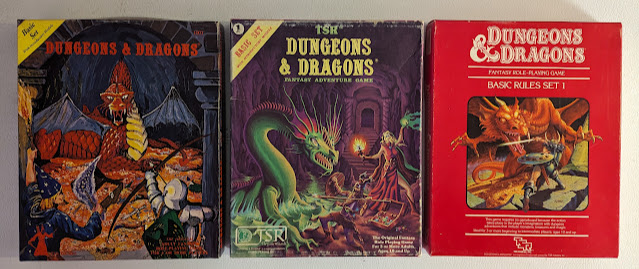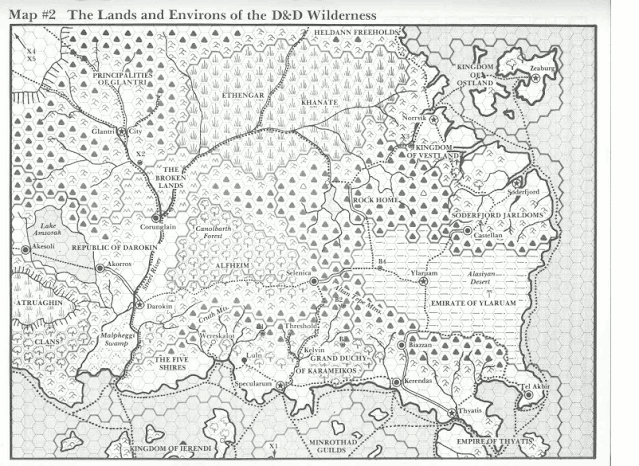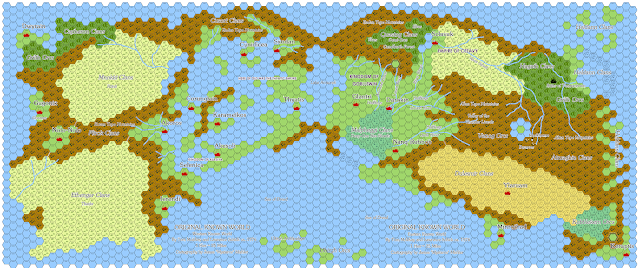NOTE: My oldest has been running his Sunday group through all the editions of D&D. I have been planning on doing something with the Cook/Marsh Expert set, but schedules being a thing I have had to adapt and now do a Companion-level adventure.
One thing led to another, and now I have a new, different project on my hands.
Today is my "Day 1" of it. The day I start pulling together research notes into a draft.
I put this post together as a set of notes and research from previous posts.
No. I am not doing my own Companion set. As I have outlined below we have plenty very good ones.
D&D Companion Set
The Companion Edition of D&D was one of the near-mythical books for me growing up. As I mentioned yesterday that I began my game playing with the Basic/Expert, known today as B/X, sets from the early 80s. The expert took the game from the 3rd to the 14th level, and the Companion book was then going to take the game from the 14th to the 36th level. Even though I knew of AD&D at the time, I thought the Companion book would be the way to go. So I waited for it.
And waited.
And waited some more.
Finally, I gave up waiting and dove into AD&D instead, leaving Basic D&D behind. Eventually, a Companion Rules Set came out. But it was for the new Mentzer-edited Basic set (now called BECMI), and I no longer had any interest in it, having discovered the world could also have Assassins, half-orcs, and 9 alignments.
Fast forward to the Old School Revolution/Renaissance/Resurgence/Recycled and I have re-discovered the Basic sets (all of them) in their imperfect glories. And I am not the only one that must have felt a little gipped by not getting a Companion book for B/X.
Jonathan Becker over at B/X Blackrazor designed his own Companion rules. If it is not exactly what the companion would be, it is really close.
Soon after, I managed to pick up my copy of the Companion Set. So join me on my exploration of the new worlds of the D&D Companion Set. But a warning, here there be Dragons!
D&D Companion Set (1984)I don't think it is too much to say that the Companion Set contains some of the most interesting changes and updates to the D&D than any other product TSR had published to date. I will talk more about these in the review, but first a look back.
I have eagerly awaited the Companion set for D&D ever since I got my Expert Set, which is by B/X Moldvay/Cook Basic and Expert Set.
The Companion Set, as promised by the Expert Set rules, mentions that characters will now go to 36th level and there will be a way to cure undead level drain! Such promises. Such hope!
 |
| D&D Cook/Marsh Expert Set, page X8 |
I did manage to read it once. I was in college, and it was at Castle Perilous Games in Carbondale. Of course, AD&D 2nd Ed was the new hotness at the time, and I had no desire to look backward. What I saw, though, at the time did not impress me. The entire Mentzer set at the time (AT THE TIME, mind you) made me think of it as D&D for little kids (now I see it differently).
Looking back now, I see I made a BIG MISTAKE.
Well...maybe. I would not have traded my AD&D time for anything, but I wish I had given the BECMI rules more chance.
Now I can fix that.
Today I am going to cover the BECMI Companion Rules. I am going to cover both the DriveThruRPG PDFs and my physical box set.
The Companion Set follows the rules as presented in the BECMI Basic and Expert books. But unlike those books, the Companion Rules sets off into uncharted directions and gives us some new material.
While the claim can be made that Frank Mentzer only edited and organized the Basic and Expert rules based on previous editions, the Companion set is all his. While there may be some influences from earlier editions such as Greyhawk (with it's 22nd level cap [wizards] and some monsters) and AD&D (some monsters and the multiverse) this really feels new.
Companion Player's Book 1
The player's book is 32 pages with color covers and black & white interiors. Art by Larry Elmore and Jeff Easley.
Opening this book we get a preface with a dedication to Brian Blume. A nice touch and yeah he is often forgotten in the tale of D&D's earliest years. The preface also firmly situates us in time. We 10 years out from when D&D was first published. The design goals of this book, and consequently this series, have never been more firmly stated. This is an introduction to the D&D game and designed to be fun, playable, and true to the spirit of D&D. It certainly feels like this is the successor to the Original D&D game; maybe more so than AD&D.
One page in and we are off to a great start.
The title and table of contents page tell us that this game is now "by" Frank Mentzer, based on D&D by Gygax and Arneson. As we move into the book proper we get a feel for the "changing game." Characters are more powerful and once difficult threats are no more than a nuisance or exercise. The characters are ready to take their place among the rulers of the world. This makes explicit something I always felt AD&D only played lip service to.
We get some new weapons that have different sorts of effects like knocking out an opponent or entangling them. We also get some unarmed combat rules. Now, these feel they really should have been added to the Basic or Expert rule sets. Maybe they were but were cut for space or time.
Up next is Stronghold management from the point of view of the player characters. Again here D&D continues its unwritten objective of being educational as well as fun. More on this in the DM's book.
Character Classes
Finally, about 11 pages in we get to the Character updates. Here all the human character classes get tables that go to level 25; again maybe a nod to Greyhawk's level 20-22 caps, and caps of 7th level spells (clerics) and 9th level spell (magic-users). Clerics get more spells and spell levels. The big upgrade comes in the form of their expanded undead turning table. Clerics up to 25th level and monsters up to Liches and Special. This mimics the AD&D Clerics table; I'd have to look at them side by side to see and differences. One difference that comes up right away is the increase in undead monsters. There are phantoms, haunts, spirits, and nightshades. Nightshades, Liches, and "Special" will be detailed in the Master Set.
Something that is big pops up in the cleric listing. A Neutral cleric of level 9 or higher may choose to become a Druid! Druids only resemble their AD&D counterparts in superficial ways. They have similar spells, but the BECMI Druid cannot change shape. It is an interesting implementation of the class, and I'll discuss it in detail.
Arguably it is fighters that get the biggest boost in the Companion Set. They gain the ability to have multiple attacks per round now and other combat maneuvers such as smashing, pairing and disarming. This is a big deal since they got so little in the Expert set. Fighters can also "specialize" into three paths depending on alignment. There are Knights, Paladins, and Avengers. Each type gives the fighter something a little extra. Paladins are not very far off from their AD&D counterparts and Avengers are as close to an Anti-Paladin as D&D will get until we get to the Blackguards.
Conversely, Magic-users do not get as much save from greater spells. We do get the restriction that any spell maxes out 20dX damage.
Thieves can now become Guildmasters or Rogues. A name that will come up more and more with future editions of D&D.
BECMI "Prestige Classes?"
The Druid, Knight, Avenger, Paladin, and, to a lesser degree, the Magist and Rogues represent what could arguably be called the first Prestige Classes to D&D. Their inclusion predates the publication of the Thief-Acrobat in the AD&D Unearthed Arcana.
The BECMI Avenger and Paladin are the best examples of these working just like the Prestige Classes will in 15 more years. This is interesting since it also means other classes can be added to the basic 4 core ones using the same system. An easy example is the Thief-Acrobat from UA or even the Ranger from AD&D. Though in this version the problem lies in the alignment system. Rangers are supposed to be "good" for example.
Demi-Humans
Demi-humans may not advance any more in level, but they are not idle. This is also the area of the Companion Set that I most often go wrong. Each demi-human race has a Clan Relic, and some demi-humans could be in charge of these clan relics, making them very powerful. There are also clan rulers, and they are also detailed. What does all that mean? It means there is a good in-game reason why demi-humans do not advance in levels anymore. They are much more dedicated to their clans than humans. So, after some time, they are expected to return home to take up their responsibilities for the clan.
That is not to say that these characters do not advance anymore. Each demi-human race can still gain "Attack Ranks" as if they are still leveling up. They don't gain any more HP, but they can attack as if they are higher-level fighters. They also gain some of the fighter's combat options. Each class gets 11 such rank-levels. It seems to split some hairs on "no more levels" but whatever.
We end with a map of the expanding Known World. This is the continent of Brun of Mystara, but we don't know that yet. But I will discuss that later this week.
This book is a lot more than I expected it to be and that is a good thing.
Companion DM's Book 2
The DM's book is 64 pages with color covers and black & white interiors. Art by Larry Elmore and Jeff Easley.
There is a lot to this book. First, we get to some General Guidelines that cover the higher levels of play and planning adventures accordingly. There is sadly not a lot here.
We follow up with Part 2: The Fantasy World. This continues some of the discussion of stronghold management and dominion management as well. Now here is quite a bit of good information on what happens, or could happen, in a dominion.
This section also includes the hidden secret of the D&D BECMI series. The War Machine Mass Combat system.
War Machine
Around the same time, TSR also developed the BattleSystem Mass Combat system. The two are largely incompatible with each other. I always thought it was odd that two systems that do essentially the same things were created and incompatible. Later I learned that D&D BECMI lived in what we like to call a "walled garden" in the business. It was out there doing it's own thing while the "real business" of AD&D was going on. The problem was that D&D Basic was outselling AD&D at this point. This was not the first time that TSR would woefully misunderstand their customers, and sadly, it was not the last time either.
War Machine is elegant compared to BattleSystem. I am not saying it is simple, but the work involved is not difficult, and I am happy to say it looks like it will work with any edition of D&D.
The Multiverse
A big part of any D&D experience is the Multiverse. This section allows the DMs and Players to dip their toes into the wider Multiverse which includes the Ethereal Plane and the Elemental Planes.
Space is also given to the discussion on aging, damage to magic items, demi-human crafts, poison, and more. We also get all of our character tables.
Monsters
About halfway through the book, we reach the monster section. Many familiar AD&D faces are now here, though a bit of digging will show that many of these are also from OD&D up to the Greyhawk supplement. Most notable are the beholder, larger dragons, druids (as monsters), and many elemental types. Monsters are split into Prime Plane and Other Planes.
Monsters from the Other Planes focus on the Elemental planes.
Treasure
Lots of new treasures and magic items.
Adventures
There are three short adventure or adventure hooks for companion-level characters.
All in all the Companion Set is full and had many things I did not think it had given my very casual relationship to it over the years. Reading it now and in-depth for the very first time I see there is a lot I could have used in my games back then.
Other Companion Books
I was not the only one that waited.
Others came up with their own Companion rules for the B/X Style Basic D&D instead of the BECMI Style Basic D&D. Now...let's be 100% honest here. The differences between BX and BECMI are so subtle that only a huge nerd like me cares. But then again, I was not the only one.
I mentioned Jonathan Becker's B/X Companion above and I reviewed it a while back. It compares favorably to the BECMI Companion from TSR, and it fits the look and feel of the BX books well.
There was also the Companion Expansion from Barrataria Games, which was also quite good. It was more of a move from BX Basic D&D closer to AD&D, which is fine. It is also free, and all the content was released 100% under the Open Gaming License, so that was a nice plus in my mind.
And proving that sometimes the wait is good, Stephen R. Marsh, the Marsh of the Cook/Marsh Expert Set, is working on his own Companion set. So I can have all three to satisfy that desire the 12-year-old-me had.
It just goes to show how active the old-school D&D communities still are.
Some part of me still wants a proper B/X Companion set from 1982. Maybe such a thing existed in an alternate universe. But that is also a universe where the BECMI sets didn't exist, and given how popular Mentzer's red box was, I am unsure how it would have changed D&D as a whole in the mid- to late 1980s.
What Role Does the Companion Serve?
One has to ask. What does the Companion rules actually do? Or even what role does it serve?
In many ways, the Companion rules (and here on out, regardless of which one I mean) represent the fork in the road where D&D splits from AD&D. With the continuum of OD&D to Holmes Basic to Moldvay and then Mentzer Basic, you could still go on to AD&D (largely as Gary would have liked). The Companion rules then are the path of no return. Once you head down that path there is no turning back for AD&D. So the Companion needs to fill the same gaps that AD&D fills, but it doesn't need to do them in the same way.
For me, any discussion about the various merits of AD&D vs Basic-era D&D has to include a conversation about how the Companion (and Masters) handle various AD&D topics. The only problem is that no Companion development ever happened in a vacuum.
Things like Druids, stronger monsters (notably elementals), the outer planes and their inhabitants, are all slightly different in the Companion rules. But rare are the entirely new elements. Granted, the BECMI Companion often has new monsters and the War Machine. The Companion Expansion from Barrataria Games was designed to fill in the gaps B/X had compared to AD&D. It is hard to throw off the shadow of AD&D. Though I would like to see something new. Something that AD&D would have to convert over from D&D for a change. But likely that time has long since passed.
Should Classes Be Different?
One of the ideas floated by the BECMI Companion is that there are some classes, the Druid is my prime example, that act like Basic Prestige Classes. So, a neutral 9th-level cleric could now be considered a Druid if that is what the player wanted. Does that mean a Fighter then could be something else? Knights, Avengers, and Paladins are mentioned in BECMI. But would Rangers, Barbarians, and Cavaliers be out of the question?
While I would not want to recreate the Prestige Class bloat of the early 2000s, the idea is an intriguing one. Would my witch even be just a type of magic-user, then?
Should Monsters Be Different?
My go-to here is the humble succubus. In Becker's Companion, she is a 7 HD monster. In BECMI, granted in the Immortal Rules, she is a whopping 15 HD (Whispering Demon in the Immortals boxed set). In Eldritch Wizardry (where she is introduced) and in AD&D she is 6+6 HD. Obviously, for characters 15th level and higher, a single 6 or 7 HD succubus is not really a challenge unless she is played correctly in a non-combat role.
Other times, we get more powerful dragons and more powerful elementals. A 15 HD succubus may be a bad idea, but the 15 HD Queen of Succubi is better.
The threats need to be targeted to the level of the characters involved.
Gives me a lot to think about.













































